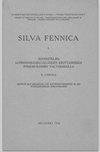瑞典森林规划系统中使用的生长函数评价
IF 1.7
3区 农林科学
Q2 FORESTRY
引用次数: 71
摘要
对瑞典森林规划系统Heureka中实施的生长模型的性能进行了评价。通过将四种基础面积增长模型的预测结果与国家森林清查(nfi)的1711个永久样地的5年生长记录数据进行比较,对四种基础面积增长模型进行了评价。此外,我们还利用苏格兰松(Pinus sylvestris L.)和挪威云杉(Picea abies (L.))间伐试验中57个区块的数据,对Heureka的两种替代实现进行了评估,分别包括林分和树级基础面积生长模型和单一树级模型。喀斯特),在第一次疏伐后对树木进行了30年的监测。预测的体积增长也与观测值进行了比较。基于1970年代和1980年代数据的增长模型高估了自2000年代初以来NFI试验区的增长约3%。林分水平模型的精度高于树级模型。在密集的nfi地块中,基底面积增长被低估,而在非稀疏的gg地块中,基底面积增长被高估,这说明了一个尚未解决的建模问题。在整个观察期,gg样地的基底面积增长也被高估了2-5%。然而,松树的体积增长被准确地预测,而云杉的体积增长被低估了2%。相对预测误差不随预测周期的延长而增大。用gg数据校准的减薄响应模型在总应用中效果良好,并根据观测结果生成了不同减薄方案的生长水平。本文章由计算机程序翻译,如有差异,请以英文原文为准。
Evaluation of growth functions used in the Swedish Forest Planning System Heureka
The performance of growth models implemented in the Swedish Forest Planning System Heureka was evaluated. Four basal area growth models were evaluated by comparing their predictions to data from five-year growth records for 1711 permanent sample plots of the National Forest Inventory (NFI-data). Also, two alternative implementations of Heureka, including a combined stand- and tree-level basal area growth model and a single tree-level model, respectively, were evaluated using data from 57 blocks in a thinning experiment (GG-data) involving Scots pine ( Pinus sylvestris L.) and Norway spruce ( Picea abies (L.) Karst) in which the trees were monitored for 30 years after the first thinning. The predicted volume growth was also compared to observed values. Growth models based on data from 1970’s and 1980’s overestimated growth in the NFI test plots from the early 2000’s by about 3%. Stand-level models had larger precision than tree-level models. Basal area growth was underestimated in dense NFI-plots and overestimated in non-thinned GG-plots, illustrating an un-solved modelling problem. Basal area growth was overestimated by 2–5% also in the GG-plots over the whole observation period. Volume growth was however accurately predicted for pine and underestimated by 2% for spruce. The relative prediction error did not increase with increasing length of prediction period. Thinning response models calibrated with GG-data worked well in the total application and produced growth levels for different thinning alternatives in line with observations.
求助全文
通过发布文献求助,成功后即可免费获取论文全文。
去求助
来源期刊

Silva Fennica
农林科学-林学
CiteScore
3.50
自引率
11.10%
发文量
21
审稿时长
3 months
期刊介绍:
Silva Fennica publishes significant new knowledge on forest sciences. The scope covers research on forestry and forest ecosystems. Silva Fennica aims to increase understanding on forest ecosystems, and sustainable use and conservation of forest resources. Use of forest resources includes all aspects of forestry containing biomass-based and non-timber products, economic and social factors etc.
 求助内容:
求助内容: 应助结果提醒方式:
应助结果提醒方式:


